4 - Finding the Right Person for the Job
Operational Profiling
Published online by Cambridge University Press: 05 January 2013
Summary
Operational profiling can be described as a process of selecting a suitable person to make a good agent. One popular introduction to the subject, a book accompanying the BBC television series Spy, highlights the role of the specialized “profiling team” that “most intelligence services will have…devoted to this hunt.” For its part, the CMPS in the 1950s focused much of its attention on the role of the individual field officer in identifying persons of operational interest. It was the officer's active involvement in the profiling process, the ministry argued, that more than any other factor determined whether or not the outcome would be successful – finding an ideally positioned individual who, in due course, would be recruited.
CSAD veterans had learned from personal experience in hostile pre-1949 environments just how crucial a task operational profiling was. Biographical sketches of the men and women who served the party on the covert front in the 1930s and 1940s record their efforts – some spectacularly successful, some disastrously misconceived – at identifying targets for recruitment who possessed in sufficient measure such key agent qualities as discretion, nerve, and self-motivation. The esoteric behavior observation skills and ability to “read” personality traits and types called for on the part of the profiler had been employed – and in a sense been turned on their head – in the Yan'an Rectification Campaign of 1942–44, in the phase known as the Rescue Campaign. Led by the then CSAD director, Kang Sheng, the Rescue Campaign had as its goal the identification of enemy agents and assets that had already penetrated or otherwise posed a potential threat to the Communist Party. Perfected and refined, the profiling skills of CSAD officers were subsequently put to good use in the Chinese Civil War (1945–49), years that Chinese intelligence historians today, quoting Mao Zedong, claim were when the party's “intelligence work was the most successful.”
- Type
- Chapter
- Information
- Spying for the PeopleMao's Secret Agents, 1949–1967, pp. 110 - 137Publisher: Cambridge University PressPrint publication year: 2013

